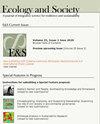苏必利尔湖马诺敏文化与生态系统特征研究
IF 3.2
2区 社会学
Q1 ECOLOGY
引用次数: 0
摘要
Manoomin,即野生稻,是阿尼什纳阿贝格人的文化、生计和身份认同中不可或缺的一部分。阿尼什纳阿贝格人是加拿大和美国的土著人民,包括奥达瓦人、奥吉布人、波塔瓦托米人和阿尔冈昆人。除了在Anishinaabeg的生活中发挥重要作用外,Manoomin还被认为具有重要的生态意义,为迁徙和居住的野生动物提供食物,为鱼类提供苗圃,为许多水禽和麝鼠提供筑巢和繁殖的栖息地,并稳定海岸线。本研究由苏必利尔湖流域Anishinaabe社区以及联邦和州机构的一个团队发起,旨在记录和描述(1)Manoomin栖息地对Anishinaabe文化视角和身份、社区联系、精神实践、粮食主权和粮食安全的重要性;(2) Manoomin生境作为高质量、高功能和生物多样性生态系统指标的生态重要性。该团队应用了一套文化和生态指标来描述苏必利尔湖周围七个案例研究地点的特征,并使用栖息地等效分析来确定平衡失去的Manoomin栖息地功能所需的恢复量。本研究结果强调了恢复退化的马诺明栖息地的文化和生态功能的困难以及保存和保护现有马诺明栖息地的重要性。本文章由计算机程序翻译,如有差异,请以英文原文为准。
Lake Superior Manoomin cultural and ecosystem characterization study
Manoomin, wild rice, is integral to the culture, livelihood, and identity of the Anishinaabeg, the indigenous peoples of Canada and the United States that include the Odawa, Ojibwe, Potawatomi, and Algonquin peoples. In addition to the vital role Manoomin has in the lives of the Anishinaabeg, Manoomin is recognized as being ecologically important, feeding migrating and resident wildlife species, providing a nursery for fish and nesting and breeding habitats for many waterfowl and muskrat, and stabilizing shorelines. This study was initiated by a team of Lake Superior basin Anishinaabe communities and federal and state agencies to document and characterize (1) the importance of Manoomin habitat to Anishinaabe cultural perspectives and identity, community connections, spiritual practices, food sovereignty, and food security; and (2) the ecological importance of Manoomin habitat as an indicator of a high-quality, high-functioning, and biodiverse ecosystem. The team applied a set of cultural and ecological metrics to characterize seven case study sites around Lake Superior and used a habitat equivalency analysis to determine the amount of restoration needed to counterbalance the lost Manoomin habitat functionality. Results from this study highlight the difficulty in restoring the cultural and ecological functionality of degraded Manoomin habitat and the importance of preserving and protecting existing Manoomin habitat.
求助全文
通过发布文献求助,成功后即可免费获取论文全文。
去求助
来源期刊

Ecology and Society
环境科学-生态学
CiteScore
6.20
自引率
4.90%
发文量
109
审稿时长
3 months
期刊介绍:
Ecology and Society is an electronic, peer-reviewed, multi-disciplinary journal devoted to the rapid dissemination of current research. Manuscript submission, peer review, and publication are all handled on the Internet. Software developed for the journal automates all clerical steps during peer review, facilitates a double-blind peer review process, and allows authors and editors to follow the progress of peer review on the Internet. As articles are accepted, they are published in an "Issue in Progress." At four month intervals the Issue-in-Progress is declared a New Issue, and subscribers receive the Table of Contents of the issue via email. Our turn-around time (submission to publication) averages around 350 days.
We encourage publication of special features. Special features are comprised of a set of manuscripts that address a single theme, and include an introductory and summary manuscript. The individual contributions are published in regular issues, and the special feature manuscripts are linked through a table of contents and announced on the journal''s main page.
The journal seeks papers that are novel, integrative and written in a way that is accessible to a wide audience that includes an array of disciplines from the natural sciences, social sciences, and the humanities concerned with the relationship between society and the life-supporting ecosystems on which human wellbeing ultimately depends.
 求助内容:
求助内容: 应助结果提醒方式:
应助结果提醒方式:


